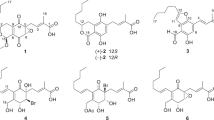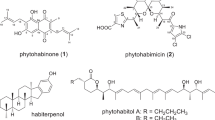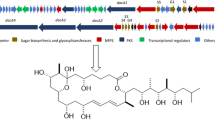Abstract
The structures of pentacecilides, new inhibitors of lipid droplet formation in mouse macrophages produced by Penicillium cecidicola FKI-3765-1, were elucidated by spectroscopic studies, including various NMR experiments. Pentacecilides have a common pentacyclic meroterpene core, which contains an aromatic ring and a δ-lactone ring.
Similar content being viewed by others
Introduction
Three new compounds, designated pentacecilides A to C (Figure 1) were isolated as inhibitors of lipid droplet formation in mouse macrophages from the culture broth of P. cecidicola FKI-3765-1.1 The taxonomy of the producing strain, fermentation, isolation and biological properties of pentacecilides were described in an earlier paper.1 In this study, the physicochemical properties and structure elucidation of pentacecilides are described.
Results
Physicochemical properties
The physicochemical properties of pentacecilides A to C are summarized in Table 1. They have a similar pattern with absorption maxima at 214–219 nm, 273–274 nm and 309–310 nm in UV spectra. IR absorption at 1619–1745 cm−1 and 3401–3434 cm−1 suggested the presence of carbonyl and hydroxy groups in their structures. These data indicated that they share a similar skeleton.
Structure elucidation of pentacecilide C
The molecular formula of pentacecilide C was determined to be C27H34O8 on the basis of HRESI-TOF-MS measurement (Table 1). The 13C NMR spectrum (in CDCl3) showed 27 resolved signals, which were classified into six methyl carbons, four methylene carbons, two sp3 methine carbons, one sp2 methine carbon, three oxygenated sp3 methine carbons, two sp3 quaternary carbons, one oxygenated sp3 quaternary carbon, three sp2 quaternary carbons, two oxygenated sp2 quaternary carbons and three carbonyl carbons by analysis of the DEPT and heteronuclear single quantum coherence (HSQC) spectra. The 1H NMR spectrum (in CDCl3) displayed 33 proton signals, one of which was suggested to be a hydroxyl proton (δ 11.08), as reported in thailandolides.2 Taking the molecular formula into consideration, the presence of another hydroxy proton was suggested. The connectivity of proton and carbon atoms was established by the 13C–1H HSQC spectrum (Table 2). Analyses of 1H–1H COSY revealed the presence of partial structures I to IV, as shown in Figure 2. Furthermore, 13C–1H long-range couplings of 2J and 3J observed in the 13C–1H HMBC spectrum gave the following linkages (Figure 3a): (1) Cross-peaks from H2-7′ (δ 2.70, 2.85) to C-1′ (δ 110.7), C-2′ (δ 139.3) and C-3′ (δ 102.2), from OH-4′ (δ 11.08) to C-3′, C-4′ (δ 162.3) and C-5′ (δ 103.5) and from H-5′ (δ 6.30) to C-1′, C-3′, C-4′ and C-6′ (δ 159.1) indicated that a phenol skeleton connects the partial structure I at C-2′. Furthermore, the findings that the chemical shift of C-8′ (δ 74.7) corresponds to an oxygenated carbon and the OH-4′ proton (δ 11.08) shifted to a lower field because of a hydrogen bonding indicated that C-3′ and C-8′ are connected through an ester bond, which form δ-lactone. This was also supported by the IR absorption (1619–1666 cm−1). Although observation of a cross-peak from H-8′ to C-10′ (δ 169.9) was important and simple to show the presence of δ-lactone, the cross-peak was not observed because the dihedral angle between H-8′ and C-10′ is 90°. Therefore, the coupling constant in HMBC experiment was changed from JC−H=8.0 Hz to JC−H=3.0 Hz. As a result, the long-range coupling of 4J from H-5′ to C-10′ was observed, supporting the presence of δ-lactone. (2) Cross-peaks from H2-11 (δ 2.52) to C-8 (δ 79.0), from H3-12 (δ 1.23) to C-7 (δ 71.8), C-8 and C-9 (δ 43.0), from H-7 (δ 4.11) to C-8 and C-9, from H-9 (δ 2.23) to C-8, C-10 (δ 36.2) and C-15 (δ 24.6), from H2-6 (δ 1.86, 2.18) to C-10, from H3-15 (δ 1.54) to C-9, C-10 and C-1 (δ 41.1), from H-5 (δ 1.82) to C-4 (δ 48.3), C-10 and C-15, from H2-1 (δ 1.88, 2.20) to C-3 (δ 207.8), C-5, C-10 and C-15, from H3-13 (δ 1.14) to C-3, C-4, C-5 and C-14 (δ 25.7), from H3-14 (δ 1.20) to C-3, C-4, C-5 and C-13 (δ 20.8) and from H-2 (δ 5.63) to C-3 showed the presence of a 3-oxo-decalin skeleton containing the partial structures II to IV. (3) Cross-peaks from H-2 and H3-17 (δ 2.17) to C-16 (δ 170.3) showed that an acetoxy group is connected to C-2. The chemical shift of C-7 (δ 71.8) and the molecular formula showed the presence of a hydroxy group. (4) The finding that cross-peaks were observed from H-11 to C-1′, C-2′ and C-6′ and that the chemical shifts of C-8 (δ 79.0) and C-6′ (δ 159.1) correspond to an oxygenated carbon indicated that a phenol and a decalin ring are connected by a pyran ring. The pentacyclic structure was found to consist of a six-membered lactone, a phenol, a pyran and a decalin ring. Thus, the structure of pentacecilide C was elucidated as shown in Figure 1. The structure satisfied the degree of unsaturation and the molecular formula. Furthermore, all chemical shifts, except for C-2 in pentacecilide C, were comparable with those reported for thailandolide A.2
Structure elucidation of pentacecilide B
The molecular formula C27H34O7 of pentacecilide B is smaller by one oxygen atom than that of pentacecilide C. Comparison of the 1H NMR spectra between pentacecilides B and C indicated that the oxygenated sp3 methine proton (H-7) in pentacecilide C is replaced by methylene protons (δ 2.10) in pentacecilide B. In fact, analyses of the 1H–1H COSY revealed the presence of the partial structure V containing the replaced part (Figure 3b). The partial structure V was also confirmed by observing cross-peaks from H3-12 (δ 1.26) to C-7 (δ 36.6), C-8 (δ 78.1) and C-9 (δ 48.5), from H2-7 (δ 2.10) to C-8, from H-9 (δ 1.88) to C-8, C-10 (δ 36.6) and C-15 (δ 24.9), from H2-6 (δ 1.68, 1.75) to C-10, from H3-15 (δ 1.39) to C-9 and C-10 and from H-5 (δ 1.77) to C-10 in 13C–1H HMBC experiments (Figure 3b). Taken together, the structure of pentacecilide B was elucidated as 7-dehydroxy pentacecilide C (Figure 1).
Structure elucidation of pentacecilide A
The molecular formula C25H32O5 of pentacecilide A is smaller by C2H2O3 than that of pentacecilide C. Comparison of the 1H NMR spectra of pentacecilides A and B showed that the methyl protons (H3-17) disappear and the oxygenated sp3 methine proton (H-2) is replaced by methylene protons (δ 2.44, 2.68). Analyses of the 1H–1H COSY revealed that the partial structure VI contains the replaced part (Figure 3c). The partial structure VI was also confirmed by observing cross-peaks from H3-15 (δ 0.96) to C-1 (δ 31.7) and C-10 (δ 35.4), from H-5 (δ 1.88) to C-4 (δ 47.2) and C-10, from H2-1 (δ 1.67, 2.06) to C-3 (δ 219.6), C-5 (δ 48.1), C-10 and C-15 (δ 23.0), from H3-13 (δ 1.09) to C-3, C-4, C-5 and C-14 (δ 29.3), from H3-14 (δ 1.12) to C-3, C-4, C-5 and C-13 (20.0) and from H2-2 to C-3 in 13C–1H HMBC experiments (Figure 3c). Taken together, the structure of pentacecilide A was elucidated as 2-deacetoxy pentacecilide B (Figure 1).
Stereochemistry of pentacecilides
Pentacecilide C has seven chiral carbons in its structure. The relative stereochemistry at C-2, C-5, C-7, C-8, C-9 and C-10 of the tricyclic skeleton (A–B–C) was investigated by NOESY experiments. As shown in Figure 4, cross-peaks were observed between H-2 (δ 5.63) and H3-13 (δ 1.20)/H3-15 (δ 1.54), between H3-15 and Hax-6 (δ 2.18)/H3-13, between H-5 (δ 1.82) and H-7 (δ 4.11)/H-9 (δ 2.23) and H-7 and H-9, indicating that they are oriented in a 1,3-diaxial conformation. Accordingly, rings A and B are oriented in a chair-chair form. Secondly, cross-peaks were observed between H3-12 (δ 1.23) and H-7/H2-11 (δ 2.52) and between H3-15 and H2-11, suggesting that rings B and C are oriented in a chair-boat form. Thirdly, cross-peaks were observed between Heq-7′ (δ 2.85) and H-11/H-8′ (δ 4.62) and between Hax-7′ and H3-9 (δ 1.55), indicating that the conformation of H3-9′ is equatorial, which was also supported by a large coupling constant (J=11 Hz) between Hax-7′ and H-8′. Taken together, the relative stereochemistry of pentacecilide C was determined as shown in Figure 1. These results were consistent with those of thailandolide A except for the stereochemistry at C-8′, although chemical shifts at C-8′ of pentacecilide C and thailandolide A were almost the same.2
The relative stereochemistry of pentacecilides A and B was deduced to be the same as that of pentacecilide C by the similarity of NOESY experiments and the coupling constants in 1H NMR.
Discussion
Pentacecilides A to C, structurally related to thailandolides, were isolated from the culture broth of P. cecidicola FKI-3765-1, and were found to have a common pentacyclic core containing an aromatic ring and a δ-lactone ring. The core seemed to be a meroterpene, consisting of a sesquiterpene and a pentaketide. Thailandolides were reported to be produced by Talaromyces thailandiasis,2 whereas pentacecilides were produced by a different genus Penicillium. Thailandolides A and B were not detected in the culture broth of P. cecidicola FKI-3765-1.
From the structure elucidation, the planar structures of pentacecilides were seen to be similar to those of thailandolides. The relative stereochemistry of the compounds is almost the same, but the C-8′ stereochemistry is different; the C-8′ methyl group of thailandolides is oriented in the axial conformation,2 whereas that of pentacecilides is in the equatorial conformation.
Methods
General experimental procedures
UV spectra were recorded on a spectrophotometer (8453 UV-Visible spectrophotometer, Agilent Technologies Inc., Santa Clara, CA, USA). IR spectra were recorded on a Fourier transform infrared spectrometer (FT-710, Horiba Ltd, Kyoto, Japan). Optical rotations were measured with a digital polarimeter (DIP-1000, JASCO Corporation, Tokyo, Japan). ESI-TOF-MS and HRESI-TOF-MS spectra were recorded on a mass spectrometer (JMS-T100LP, JEOL Ltd, Tokyo, Japan). Various NMR spectra were measured with a spectrometer (XL-400, Varian Inc., Palo Alto, CA, USA).
References
Yamazaki, H et al. Pentacecilides, new inhibitors for lipid droplet formation in mouse macrophages produced by Penicillium cecidicola FKI-3765-1. I. Taxonomy, fermentation, isolation and biological properties. J. Antibiot. 62, 195–200 (2009).
Dethoup, T et al. Merodrimanes and other constituents from Talaromyces thailandiasis. J. Nat. Prod. 70, 1200–1202 (2007).
Acknowledgements
This study was supported by the Program for the Promotion of Fundamental Studies in Health Sciences (to HT) from the National Institute of Biomedical Innovation (NIBIO). We express our thanks to Ms N Sato for measuring NMR experiments, and Mr K Nagai and Ms A Nakagawa for measuring mass spectra. We also thank Mr N Ugaki for excellent technical assistance.
Author information
Authors and Affiliations
Corresponding author
Rights and permissions
About this article
Cite this article
Yamazaki, H., Ōmura, S. & Tomoda, H. Pentacecilides, new inhibitors of lipid droplet formation in mouse macrophages produced by Penicillium cecidicola FKI-3765-1: II. Structure elucidation. J Antibiot 62, 207–211 (2009). https://doi.org/10.1038/ja.2009.19
Received:
Revised:
Accepted:
Published:
Issue Date:
DOI: https://doi.org/10.1038/ja.2009.19
Keywords
This article is cited by
-
Exploration of marine natural resources in Indonesia and development of efficient strategies for the production of microbial halogenated metabolites
Journal of Natural Medicines (2022)
-
Using self-organizing map (SOM) and support vector machine (SVM) for classification of selectivity of ACAT inhibitors
Molecular Diversity (2013)
-
Absolute stereochemistry of pentacecilides, new inhibitors of lipid droplet formation in mouse macrophages, produced by Penicillium cecidicola FKI-3765-1
The Journal of Antibiotics (2010)
-
Pentacecilides, new inhibitors of lipid droplet formation in mouse macrophages, produced by Penicillium cecidicola FKI-3765-1: I. Taxonomy, fermentation, isolation and biological properties
The Journal of Antibiotics (2009)







